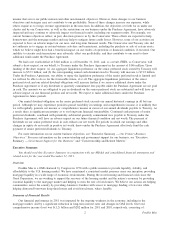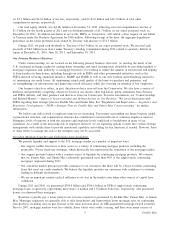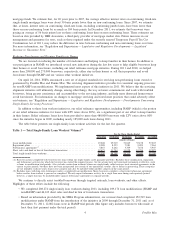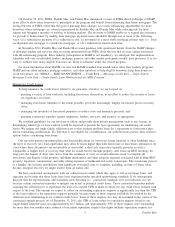Freddie Mac 2011 Annual Report Download - page 17
Download and view the complete annual report
Please find page 17 of the 2011 Freddie Mac annual report below. You can navigate through the pages in the report by either clicking on the pages listed below, or by using the keyword search tool below to find specific information within the annual report.-
 1
1 -
 2
2 -
 3
3 -
 4
4 -
 5
5 -
 6
6 -
 7
7 -
 8
8 -
 9
9 -
 10
10 -
 11
11 -
 12
12 -
 13
13 -
 14
14 -
 15
15 -
 16
16 -
 17
17 -
 18
18 -
 19
19 -
 20
20 -
 21
21 -
 22
22 -
 23
23 -
 24
24 -
 25
25 -
 26
26 -
 27
27 -
 28
28 -
 29
29 -
 30
30 -
 31
31 -
 32
32 -
 33
33 -
 34
34 -
 35
35 -
 36
36 -
 37
37 -
 38
38 -
 39
39 -
 40
40 -
 41
41 -
 42
42 -
 43
43 -
 44
44 -
 45
45 -
 46
46 -
 47
47 -
 48
48 -
 49
49 -
 50
50 -
 51
51 -
 52
52 -
 53
53 -
 54
54 -
 55
55 -
 56
56 -
 57
57 -
 58
58 -
 59
59 -
 60
60 -
 61
61 -
 62
62 -
 63
63 -
 64
64 -
 65
65 -
 66
66 -
 67
67 -
 68
68 -
 69
69 -
 70
70 -
 71
71 -
 72
72 -
 73
73 -
 74
74 -
 75
75 -
 76
76 -
 77
77 -
 78
78 -
 79
79 -
 80
80 -
 81
81 -
 82
82 -
 83
83 -
 84
84 -
 85
85 -
 86
86 -
 87
87 -
 88
88 -
 89
89 -
 90
90 -
 91
91 -
 92
92 -
 93
93 -
 94
94 -
 95
95 -
 96
96 -
 97
97 -
 98
98 -
 99
99 -
 100
100 -
 101
101 -
 102
102 -
 103
103 -
 104
104 -
 105
105 -
 106
106 -
 107
107 -
 108
108 -
 109
109 -
 110
110 -
 111
111 -
 112
112 -
 113
113 -
 114
114 -
 115
115 -
 116
116 -
 117
117 -
 118
118 -
 119
119 -
 120
120 -
 121
121 -
 122
122 -
 123
123 -
 124
124 -
 125
125 -
 126
126 -
 127
127 -
 128
128 -
 129
129 -
 130
130 -
 131
131 -
 132
132 -
 133
133 -
 134
134 -
 135
135 -
 136
136 -
 137
137 -
 138
138 -
 139
139 -
 140
140 -
 141
141 -
 142
142 -
 143
143 -
 144
144 -
 145
145 -
 146
146 -
 147
147 -
 148
148 -
 149
149 -
 150
150 -
 151
151 -
 152
152 -
 153
153 -
 154
154 -
 155
155 -
 156
156 -
 157
157 -
 158
158 -
 159
159 -
 160
160 -
 161
161 -
 162
162 -
 163
163 -
 164
164 -
 165
165 -
 166
166 -
 167
167 -
 168
168 -
 169
169 -
 170
170 -
 171
171 -
 172
172 -
 173
173 -
 174
174 -
 175
175 -
 176
176 -
 177
177 -
 178
178 -
 179
179 -
 180
180 -
 181
181 -
 182
182 -
 183
183 -
 184
184 -
 185
185 -
 186
186 -
 187
187 -
 188
188 -
 189
189 -
 190
190 -
 191
191 -
 192
192 -
 193
193 -
 194
194 -
 195
195 -
 196
196 -
 197
197 -
 198
198 -
 199
199 -
 200
200 -
 201
201 -
 202
202 -
 203
203 -
 204
204 -
 205
205 -
 206
206 -
 207
207 -
 208
208 -
 209
209 -
 210
210 -
 211
211 -
 212
212 -
 213
213 -
 214
214 -
 215
215 -
 216
216 -
 217
217 -
 218
218 -
 219
219 -
 220
220 -
 221
221 -
 222
222 -
 223
223 -
 224
224 -
 225
225 -
 226
226 -
 227
227 -
 228
228 -
 229
229 -
 230
230 -
 231
231 -
 232
232 -
 233
233 -
 234
234 -
 235
235 -
 236
236 -
 237
237 -
 238
238 -
 239
239 -
 240
240 -
 241
241 -
 242
242 -
 243
243 -
 244
244 -
 245
245 -
 246
246 -
 247
247 -
 248
248 -
 249
249 -
 250
250 -
 251
251 -
 252
252 -
 253
253 -
 254
254 -
 255
255 -
 256
256 -
 257
257 -
 258
258 -
 259
259 -
 260
260 -
 261
261 -
 262
262 -
 263
263 -
 264
264 -
 265
265 -
 266
266 -
 267
267 -
 268
268 -
 269
269 -
 270
270 -
 271
271 -
 272
272 -
 273
273 -
 274
274 -
 275
275 -
 276
276 -
 277
277 -
 278
278 -
 279
279 -
 280
280 -
 281
281 -
 282
282 -
 283
283 -
 284
284 -
 285
285 -
 286
286 -
 287
287 -
 288
288 -
 289
289 -
 290
290 -
 291
291 -
 292
292 -
 293
293 -
 294
294 -
 295
295 -
 296
296 -
 297
297 -
 298
298 -
 299
299 -
 300
300 -
 301
301 -
 302
302 -
 303
303 -
 304
304 -
 305
305 -
 306
306 -
 307
307 -
 308
308 -
 309
309 -
 310
310 -
 311
311 -
 312
312 -
 313
313 -
 314
314 -
 315
315 -
 316
316 -
 317
317 -
 318
318 -
 319
319 -
 320
320 -
 321
321 -
 322
322 -
 323
323 -
 324
324 -
 325
325 -
 326
326 -
 327
327 -
 328
328 -
 329
329 -
 330
330 -
 331
331 -
 332
332 -
 333
333 -
 334
334 -
 335
335 -
 336
336 -
 337
337 -
 338
338 -
 339
339 -
 340
340 -
 341
341 -
 342
342 -
 343
343 -
 344
344 -
 345
345 -
 346
346 -
 347
347 -
 348
348 -
 349
349 -
 350
350 -
 351
351 -
 352
352 -
 353
353 -
 354
354 -
 355
355 -
 356
356 -
 357
357 -
 358
358 -
 359
359 -
 360
360 -
 361
361 -
 362
362 -
 363
363 -
 364
364 -
 365
365 -
 366
366 -
 367
367 -
 368
368 -
 369
369 -
 370
370 -
 371
371 -
 372
372 -
 373
373 -
 374
374 -
 375
375 -
 376
376 -
 377
377 -
 378
378 -
 379
379 -
 380
380 -
 381
381 -
 382
382 -
 383
383 -
 384
384 -
 385
385 -
 386
386 -
 387
387 -
 388
388 -
 389
389 -
 390
390 -
 391
391 -
 392
392 -
 393
393
 |
 |

mortgage market. In most instances, we use the mortgage securitization process to package the purchased mortgage loans
into guaranteed mortgage-related securities. We guarantee the payment of principal and interest on the mortgage-related
security in exchange for management and guarantee fees.
Our Customers
Our customers are predominantly lenders in the primary mortgage market that originate mortgages for homeowners.
These lenders include mortgage banking companies, commercial banks, savings banks, community banks, credit unions,
HFAs, and savings and loan associations.
We acquire a significant portion of our mortgages from several large lenders. These lenders are among the largest
mortgage loan originators in the U.S. Since 2007, the mortgage industry has consolidated significantly and a smaller
number of large lenders originate most single-family mortgages. As a result, mortgage origination volume during 2011
was concentrated in a smaller number of institutions. During 2011, two mortgage lenders (Wells Fargo Bank, N.A. and
JPMorgan Chase Bank, N.A.) each accounted for more than 10% of our single-family mortgage purchase volume and
collectively accounted for approximately 40% of our single-family mortgage purchase volume. Our top ten lenders
accounted for approximately 82% of our single-family mortgage purchase volume during 2011.
Our customers also service loans in our single-family credit guarantee portfolio. A significant portion of our single-
family mortgage loans are serviced by several of our large customers. Because we do not have our own servicing
operation, if our servicers lack appropriate process controls, experience a failure in their controls, or experience an
operating disruption in their ability to service mortgage loans, our business and financial results could be adversely
affected. For information about our relationships with our customers, see “MD&A — RISK MANAGEMENT — Credit
Risk — Institutional Credit Risk — Single-Family Mortgage Seller/Servicers.”
Our Competition
Historically, our principal competitors have been Fannie Mae, Ginnie Mae and FHA/VA, and other financial
institutions that retain or securitize mortgages, such as commercial and investment banks, dealers, and thrift institutions.
Since 2008, most of our competitors, other than Fannie Mae, Ginnie Mae, and FHA/VA, have ceased their activities in the
residential mortgage securitization business or severely curtailed these activities relative to their previous levels. We
compete on the basis of price, products, the structure of our securities, and service. Competition to acquire single-family
mortgages can also be significantly affected by changes in our credit standards.
Ginnie Mae, which became a more significant competitor beginning in 2009, guarantees the timely payment of
principal and interest on mortgage-related securities backed by federally insured or guaranteed loans, primarily those
insured by FHA or guaranteed by VA. Ginnie Mae maintained a significant market share in 2011 and 2010, in large part
due to favorable pricing of loans insured by FHA, the increase in the FHA loan limit and the availability, through FHA,
of a mortgage product for borrowers seeking greater than 80% financing who could not otherwise qualify for a
conventional mortgage.
The conservatorship, including direction provided to us by our Conservator, and the restrictions on our activities
under the Purchase Agreement may affect our ability to compete in the business of securitizing mortgages. On multiple
occasions, FHFA has directed us and Fannie Mae to confer and suggest to FHFA possible uniform approaches to
particular business and accounting issues and problems. In most such cases, FHFA subsequently directed us and Fannie
Mae to adopt a specific uniform approach. It is possible that in some areas FHFA could require us and Fannie Mae to
take a uniform approach that, because of differences in our respective businesses, could place Freddie Mac at a
competitive disadvantage to Fannie Mae. For more information, see “RISK FACTORS — Conservatorship and Related
Matters — FHFA directives that we and Fannie Mae adopt uniform approaches in some areas could have an adverse
impact on our business or on our competitive position with respect to Fannie Mae.”
Overview of the Mortgage Securitization Process
Mortgage securitization is a process by which we purchase mortgage loans that lenders originate, and pool these
loans into mortgage securities that are sold in global capital markets. The following diagram illustrates how we support
12 Freddie Mac
